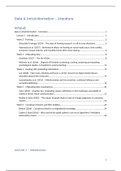Summary
Summary Data & (mis)information
- Course
- Institution
A summary of the course Data and (mis)information (). The notes from the lectures as well as the main information of all articles are provided in this summary, including examples that are helpful for the exam.
[Show more]



